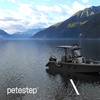C-Job Designs Flettner Freighter for Switijnk
Revolutionary Wind Assisted Propulsion design will be applied to 8,000 DWT General Cargo vessel.
The Dutch shipping company family Switijnk has contracted C-Job Naval Architects to develop a Rotor Sail-equipped design to meet their specific loading and sailing profile. The contract follows the substantial media attention for the 4,500 DWT Flettner Freighter (the FF4500) which C-Job Naval Architects developed as part of the European Union Interreg project SAIL.
Taking the project name of FF8000, the design will be for a dry cargo ship with 8,000 ton deadweight. Although based on the existing FF4500 design, the new design will include numerous modifications.
“Sustainable development is part of our future-proof philosophy as a family business”
Norsepower, the Finnish company that markets rotorsails (also known as Flettner rotors) is also involved in the initial stages of the innovative ship. The company has performed accurate estimates of the FF8000’s sailing profile based on the positive test results from the existing car carrier MS Estraden. Director Stefan Switijnk says: “Sustainable development is part of our future-proof philosophy as a family business.”
Being innovative
Despite the current low price of oil, Switijnk values the importance of thinking ahead and being innovative. Moreover, the company wants to leave the world in a decent state for the next generation. Unlike the FF4500, alternative fuel options are being examined for the FF8000. Switijnk: “Although still fossil-based, LNG could be a link in the current energy transition to more sustainable energy sources. We are also considering other alternatives such as biofuels.” By selecting Rotor Sails, the family will lead the way in the next phase of the transport industry.
Hybrid design by Magnus effect
The Flettner Freighter is a 131-metre long vessel design for an 8,000 DWT dry cargo ship. The combination of the specially designed hull, the rotorsails and the LNG propulsion forms a sustainable concept by which energy costs and emissions are reduced. This form of ‘Hybrid Wind Assisted Shipping’ consists of vertical rotating cylinders that convert crosswinds into forward thrust by means of the ‘Magnus effect’.
The first
It is the first time in which the combination of modern rotorsails, a C-Job optimised hull and alternative fuels has been applied to the commercial shipping market. The design can therefore be classified as very sustainable. Switijnk is currently focusing its attention on finding partners to develop and finance this innovative ship. The company currently has two other ships in service.
Convincing design
C-Job Naval Architects, known for other innovative ships such as the hybrid CNG-Electric ferry Texelstroom and the LNG-powered TSHD Bonny River for DEME, is currently putting the finishing touch to the FF8000 design. Jelle Grijpstra, Business Manager at C-Job comments: “We often find that a design really comes to life through a 3D design, which we always use in the Concept Design phase. It really sparks people’s interest and makes for a convincing design.”










